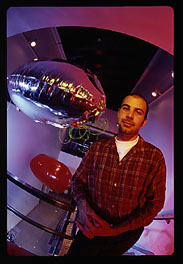

I, RoboticistSo you're talking to this person in a cafe, only it's not a person, it's a small blimp hovering in your face. You keep talking to it, even though you feel pretty strange asking this blimp questions. But the blimp is answering you, so maybe you're not crazy. Then you forget it's a blimp and clue back in to the fact that you're engaged in conversation with your best friend who you haven't hung out with for over a year because he lives in Italy. And you're not hallucinating. See, the blimp is an avatar and it just happens to be mylar. That surreal vision is what keeps twenty-six year old Eric Paulos , a computer science graduate student at UC Berkeley, in the laboratory all night, every night. Eric is a roboticist and he plays with the most intense erector set imaginable-complex amalgamations of gears, motors, wires and chips he designs and programs to intensify the technology-mediated human experience. With a lot of ingenuity and a little helium, Eric's vision is becoming a reality. Inside the robotics laboratory at Berkeley, the blimp hovers quietly, awaiting its next command from cyberspace. Equipped with a wireless video camera and microphone and controllable over the Web via remote control, the dirigible empowers you with the ability to explore environments as far away as the telcos' twisted pair will take you. Log into Paulos' "Interfacing Reality" site and experience the blimp's eye-view -a floaty, dreamy vision that somehow brings to mind the perspective of an ameba swimming through its watery universe. "The idea is to convey the sensation of actually walking through a space," says Paulos, fresh from a ride on his Moto Guzzi motorcycle. "The blimp works really well because it's sort of the same size as a person. It can cohabitate with other people as opposed to some small robotic creature crawling around the floor." Kicking back in his kitchen wearing the gearhead garb of a work shirt, jeans and steel-toe kickers, Eric has no trouble remembering when he first became enraptured with robots. He was a teenager, hooked by a random public television documentary on robots that hopped around kangaroo-style in a university laboratory. It was a bizarre scene that Eric never forgot. High school and computer nrrrd-dom followed with weekend nights of hacking and Trivial Pursuit with his buddies. During his undergrad studies at Berkeley, Paulos' forte was computer programming. But just before graduation, he took a welding class in the art department and discovered a new creative outlet of steel and flames. That experience, combined with a high-level robotics course he took on a whim, led Eric to his true calling. "I realized that all the things I enjoyed outside of school could be incorporated into my research," says Paulos, who recently brought his Net knowledge to machine performance group Survival Research Laboratories. Don't bother looking for the blimp in Circuit City just yet. Eric predicts that a fully tricked-out $300 version could be on store shelves in 1998, but right now he and his advisor, robotics guru John Canny , are still busy experimenting with prototypes. The next step is to equip the flying robot with a rear-projection system to shine a real-time video image of the user onto the blimp's surface. "We definitely don't want this thing to look like a cheesy inflatable person, but facial expressions are extremely important in conversation," he points out. The blimp is Paulos' second Web telepresence project. His first, "Mechanical Gaze," enables users to view exhibits in a gallery from anywhere in the world. The virtual eyeball is a videocamera attached to an industrial robotic arm, maneuverable from a simple interface on a refreshing Web page. Move the metal appendage to survey the odd artifacts in the ever-changing Mechanical Gaze gallery in Berkeley, before zooming in for a closer look at the multicolored fungi on display. If you still question whether the artifacts are live or digitized, run CU-SeeMe and watch from the sidelines as the arm pans at your command. "People who can't travel to see a museum collection in person will definitely benefit from technology that delivers the sensation of being there," Eric says. "If you're allowed to change the view of the camera, you can have some sensation of wandering around a remote space. This way people can look at their own pace, from their own viewpoint, like they do when actually are inside a museum." Paulos is clear about his R&D agenda-if you can't bring Mohammed to the mountain.... "But we're not trying to replace the direct human experience," he is quick to interject. "This technology is designed to extend that experience." The robotocist is already churning out his next idea, scribbling plans and specs in his ever-present ragged notebook. He's ready for the next leg of his telerobotic trip-the development of technology that will give users the sensation of pushing through the Internet's virtual membrane to touch the person on the other end. Eric's working name for his tactile telepresence endeavor? Feel-U Feel- Me, of course. |

|